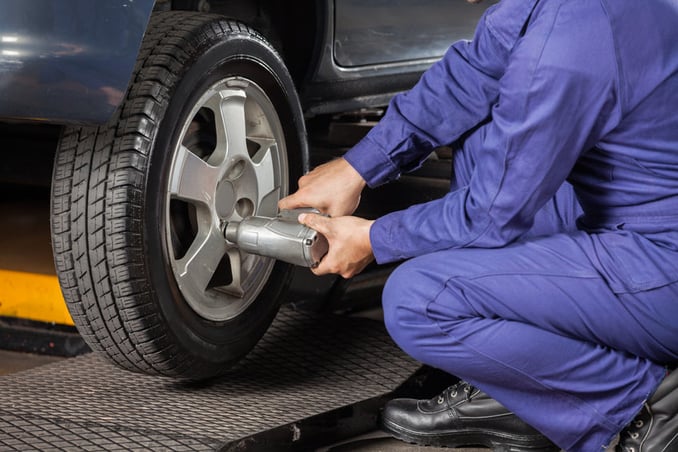Unlock Performance: Professional GMC Tire Service at Morris Tires
Unlock Performance: Professional GMC Tire Service at Morris Tires
Blog Article
Tire Service: The Impact of Weather Condition Problems
When it comes to guaranteeing optimal performance and safety and security on the roadway, comprehending the impact of climate conditions on tire solution is critical. GMC Tire Service. In this conversation, we will explore the elaborate relationship between weather condition conditions and tire solution, shedding light on the significance of weather-specific tire upkeep techniques and considerations.
Heat and Tire Efficiency
When subjected to high temperature levels, tires experience adjustments in efficiency that can substantially influence car safety and security and handling. The warm created from extended driving or warm weather condition problems creates the tire rubber to soften, leading to decreased step life and increased wear.

Winter Effects
Cold weather condition conditions can have a substantial influence on tire efficiency and security. As temperature levels drop, tire rubber can solidify, bring about reduced grip on icy or snow-covered roads. In cold climate, tires may additionally lose atmospheric pressure a lot more rapidly, which can affect taking care of and fuel performance. In addition, cold temperature levels can create tire sidewalls to stiffen, increasing the threat of damages from potholes or various other road dangers.
To alleviate the results of cool weather condition on tires, it is vital to on a regular basis examine tire pressure and inflate them to the producer's advised degrees. Utilizing winter or all-season tires developed for chilly climate conditions can additionally enhance traction and grip on icy or snowy roadways. Correct tire maintenance, including routine evaluations for wear and damages, comes to be also much more vital throughout chillier months to make certain optimum performance and security.
Rainy Issues Influence
During rainy problems, tire performance and safety can be dramatically influenced by the wet road surface areas and reduced visibility. The walk pattern of tires plays a critical role in keeping grip on damp roads. Tires with worn-out treads are more vulnerable to hydroplaning, where a layer of water develops in between the tire and the roadway surface, resulting in loss of traction. To fight this, drivers should routinely examine their tires for adequate walk deepness and take into consideration purchasing tires particularly designed for wet problems.
Additionally, wet weather condition can also decrease exposure, making it challenging for chauffeurs to see the roadway in advance plainly (GMC Tire Service). In such conditions, it is important to readjust driving speeds accordingly and preserve a safe adhering to distance to permit abrupt stops. Appropriately filled with air tires can additionally help in maintaining control on wet roads by providing far better handling and grip
Snow and Tire Safety
When driving in snowy problems, having the best tires can sites make a substantial distinction in security and performance. Winter season tires are made with special rubber substances and step patterns to supply better traction on snow and ice contrasted to all-season tires.

Furthermore, motorists must think about mounting tire chains in severe snowy problems. Tire chains give added traction by clutching the snow and ice, enhancing stability and control. Nonetheless, it is vital to adhere to producer instructions when setting up and making use of tire chains to avoid damages to the tires and lorry. By picking the appropriate tires, maintaining proper rising cost of living, and considering added grip aids like tire chains, vehicle drivers can improve their safety and security when navigating snow-covered roads.
Weather-Related Tire Maintenance
When faced with numerous weather, appropriate tire upkeep comes to be a crucial facet of car safety and security and efficiency. Weather-related tire maintenance includes a variety of techniques aimed at ensuring optimum tire feature and long life in various climate scenarios. One key aspect of weather-related tire maintenance is tire stress policy. Changing temperature levels can trigger tire stress to differ, affecting traction and gas performance. Frequently changing and inspecting tire pressure according to producer referrals is crucial for risk-free driving in changing weather. Furthermore, tire tread deepness plays a considerable function in taking care of different climate aspects. Tires with adequate walk depth supply better grip on damp or icy roadways, minimizing the danger of hydroplaning or skidding. Evaluating tire step on a regular basis and replacing tires when step wear reaches a certain depth is vital for maintaining traction and security in unfavorable weather condition. By focusing on weather-related tire maintenance, drivers can enhance safety, improve vehicle efficiency, and lengthen the life expectancy of their tires.
Conclusion
In final thought, weather have a significant impact on tire efficiency and security. From warm impacting tire stress and use to chilly learn this here now climate decreasing grip, it is necessary to consider the climate when keeping and utilizing tires. Rainy conditions can decrease hold and result in hydroplaning, while snow can raise the danger of mishaps if tires are not effectively geared up. Weather-related tire upkeep other is important in making certain ideal efficiency and security on the roadways.
In this conversation, we will discover the intricate partnership in between climate problems and tire service, dropping light on the relevance of weather-specific tire maintenance practices and factors to consider.

Report this page